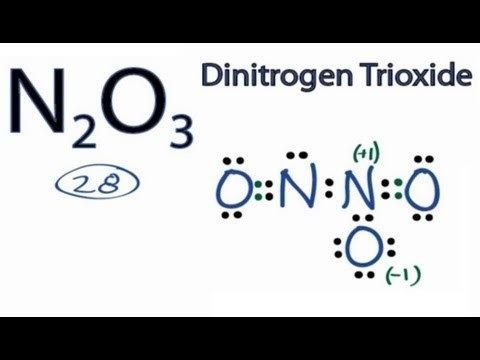Related compounds Molar mass 76.01 g/mol Density 1.4 g/cm³ | Formula N2O3 Boiling point 3 °C Appearance deep blue liquid | |
 | ||
Preparation of dinitrogen trioxide
Dinitrogen trioxide is the chemical compound with the formula N2O3. This deep blue solid is one of the binary nitrogen oxides. It forms upon mixing equal parts of nitric oxide and nitrogen dioxide and cooling the mixture below −21 °C (−6 °F):
Contents
- Preparation of dinitrogen trioxide
- Formation of dinitrogen trioxide n2o3
- Structure and bonding
- References
Dinitrogen trioxide is only isolable at low temperatures, i.e. in the liquid and solid phases. At higher temperatures the equilibrium favors the constituent gases, with Kdiss = 193 kPa (25 °C).
Formation of dinitrogen trioxide n2o3
Structure and bonding
Typically, N–N bonds are similar in length to that in hydrazine (145 pm). Dinitrogen trioxide, however, has an unusually long N–N bond at 186 pm. Some other nitrogen oxides do also possess long N–N bonds, including dinitrogen tetroxide (175 pm). The N2O3 molecule is planar and exhibits Cs symmetry. The dimensions displayed below come from microwave spectroscopy of low-temperature, gaseous N2O3:
It is the anhydride of the unstable nitrous acid (HNO2), and produces it when mixed into water. An alternative structure might be anticipated for the true anhydride, i.e. O=N–O–N=O, but this isomer is not observed. If the nitrous acid is not then used up quickly, it decomposes into nitric oxide and nitric acid. Nitrite salts are sometimes produced by adding N2O3 to solutions of bases:
N2O3 + 2 NaOH → 2 NaNO2 + H2O